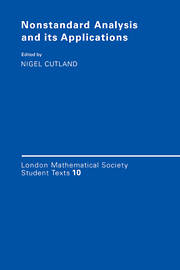Book contents
- Frontmatter
- Contents
- Preface
- Contributors
- AN INVITATION TO NONSTANDARD ANALYSIS
- INFINITESIMALS IN PROBABILITY THEORY
- INFINITESIMALS IN FUNCTIONAL ANALYSIS
- APPLICATIONS OF NONSTANDARD ANALYSIS IN MATHEMATICAL PHYSICS
- A LATTICE FORMULATION OF REAL AND VECTOR VALUED INTEGRALS
- AN APPLICATION OF NONSTANDARD METHODS TO COMPUTATIONAL GROUP THEORY
- SYNTACTICAL METHODS IN INFINITESIMAL ANALYSIS
- SOME ASYMPTOTIC RESULTS IN ORDINARY DIFFERENTIAL EQUATIONS
- SUPERINFINITESINALS AND INDUCTIVE LIMITS
- THE NON-LINEAR BOLTZMANN EQUATION FAR FROM EQUILIBRIUM
- INDEX
THE NON-LINEAR BOLTZMANN EQUATION FAR FROM EQUILIBRIUM
Published online by Cambridge University Press: 05 June 2012
- Frontmatter
- Contents
- Preface
- Contributors
- AN INVITATION TO NONSTANDARD ANALYSIS
- INFINITESIMALS IN PROBABILITY THEORY
- INFINITESIMALS IN FUNCTIONAL ANALYSIS
- APPLICATIONS OF NONSTANDARD ANALYSIS IN MATHEMATICAL PHYSICS
- A LATTICE FORMULATION OF REAL AND VECTOR VALUED INTEGRALS
- AN APPLICATION OF NONSTANDARD METHODS TO COMPUTATIONAL GROUP THEORY
- SYNTACTICAL METHODS IN INFINITESIMAL ANALYSIS
- SOME ASYMPTOTIC RESULTS IN ORDINARY DIFFERENTIAL EQUATIONS
- SUPERINFINITESINALS AND INDUCTIVE LIMITS
- THE NON-LINEAR BOLTZMANN EQUATION FAR FROM EQUILIBRIUM
- INDEX
Summary
Abstract. This paper surveys the theory of Loeb solutions of the mild, space-dependent Boltzmann equation under natural initial conditions of finite mass, energy, and entropy. The existence theory for large initial data is presented, and compared with the classical theory. The limit of zero mean free path and infinite time are also discussed, including some new results.
INTRODUCTION
Consider the Boltzmann equation, that famous kinetic model of rarefied gases driven by binary collisons. Since a linearization would remove some of the interesting behaviour, we shall here retain the truly non-linear collision mechanism.
A fairly common characteristic of non-linear evolution equations is that the behaviour close to equilibrium is smooth and regular with nice asymptotic convergence, whereas initial values further away may result in wilder, possibly non-smooth behaviour. For space-dependent Boltzmann gases in full space or bounded containers, various contraction mapping estimates can be used to prove the existence of unique, smooth solutions converging to an equilibrium (Maxwellian) value with time, if the initial values are close enough to equilibrium. Such methods break down when the initial values are further away from equilibrium, and so do natural compactness arguments.
For another approach, let us first recall the physical background. From the point of view of physics, what happens at distances or within volumes below, say, the scale of elementary particle phenomena, is an artefact of the model with little experimental relevance. From this perspective, the question whether the model starts from an underlying set of rationally, really, or infinitesimally spaced points, should be decided purely on mathematical grounds.
- Type
- Chapter
- Information
- Nonstandard Analysis and its Applications , pp. 321 - 340Publisher: Cambridge University PressPrint publication year: 1988
- 2
- Cited by



